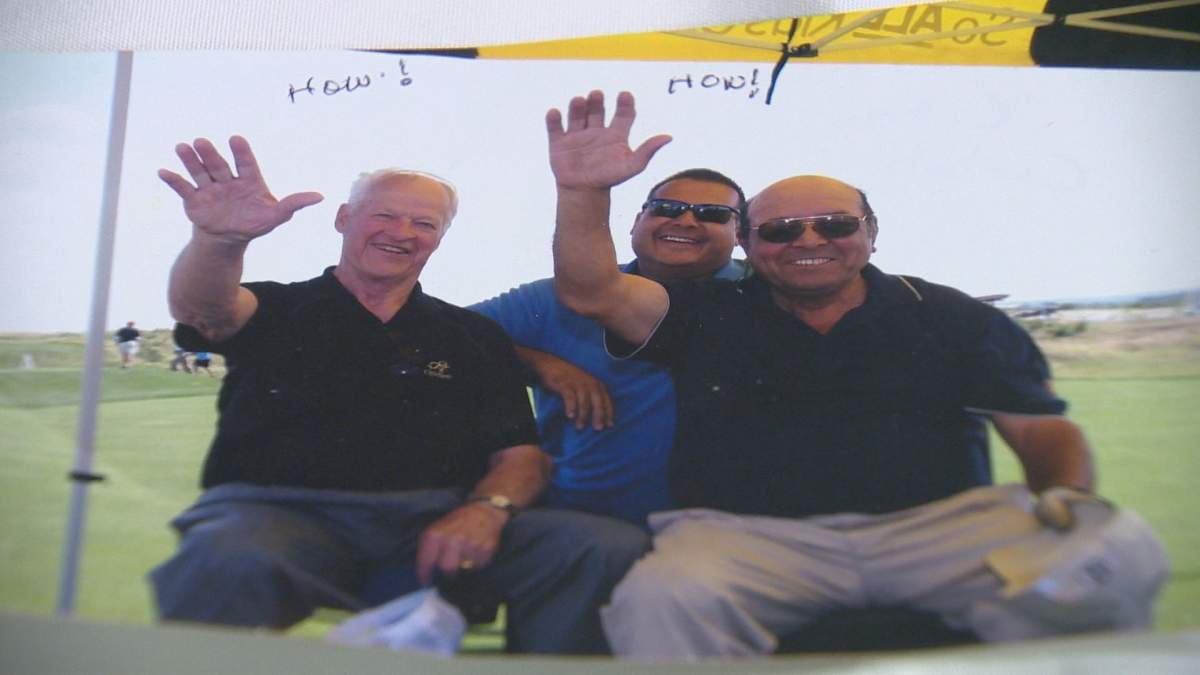Fred Sasakamoose made history in 1954.

At the age of 20, he skated onto the ice at Maple Leaf Gardens and became the first indigenous person to play in the National Hockey League (NHL).
“That is an unforgettable memory of my life, to be able to reach and become and NHLer,” said Sasakamoose, who was born on the Sandy Lake Reserve in Saskatchewan.
READ MORE: Fred Sasakamoose and Ted Nolan concerned about future of aboriginal hockey
When Sasakamoose was 16, he tried out for the Moose Jaw Canucks in the Western Canada Junior Hockey League, but homesickness threatened to end his career. He even ran away once, getting as far as Chamberlain by foot, a 55-kilometre journey.
His coach, George Vogan, found him and persuaded him to stay.
“I wanted to come home, I didn’t fit in this world. White kids, 130 of them,” explained Sasakamoose.
WATCH BELOW: Fred Sasakamoose overcame monumental obstacles to succeed in the world of hockey

His grandfather taught Sasakamoose how to skate when he was six. While his grandfather couldn’t talk or hear, he could see, and he would put three pairs of socks on Sasakamoose’s feet, then moccasins and strap on a pair of bob skates.

Get daily National news
He took two willows, cut then into the shape of a hockey stick and dried them by the fire to harden their frame. The puck he used was made of frozen horse manure. They would spend hours together on the pond near the reserve.
When Sasakamoose was seven, he was removed from his First Nations home in northern Saskatchewan and taken 500 kilometres away from his parents to attend St. Michael’s Residential School in Duck Lake.
“It’s hard to talk about residential school. There were a lot of things in there, that … well. Every Saturday night, we listened to Hockey Night in Canada, a whole bunch of us kids on this cement floor.”
WATCH BELOW: Obstacles aboriginal kids face as they try to realize their hockey dreams

Sasakamoose couldn’t afford a hockey stick, so he would work in the barn or sell his apple at lunch for extra money at St. Michael’s. Over two years, he saved up enough money for a proper stick.
His team, the St. Michael’s Mallards, or as Sasakamoose says, “the original Mighty Ducks,” would capture the 1948 Northern Saskatchewan Midget Hockey Championships.
Eventually, Sasakamoose achieved what seemed the impossible and earned a spot on the roster of the Chicago Blackhawks.
“Only 125 hockey players and six teams, and I was one of them,” noted the 83-year-old.
READ MORE: Teaching aboriginal culture through hockey
Compared to residential schools, hockey was a stark contrast for Sasakamoose.
“It didn’t matter about your colour, you were a team. You played to win, you played to win together.”
Ted Nolan, a former NHL player and coach, grew up on a reserve near Sault Ste Marie, Ont. He arrived on the hockey scene 30 years later and credits Sasakamoose and other indigenous players for paving the way.
“All the guys on TV who had brown faces, those are guys that were inspirations for us. If they could, maybe we could, too.”
But just like Sasakmoose, the success on the ice didn’t come easy.
“When things are tough, one of the easiest things people do in life is to quit. You just have to find a way to persevere if that’s something that you truly believe that you can do,” Nolan said.
“And for whatever reason I believed I could when I was skating with those Size 6 skates on a reserve with my feet being Size 3. No equipment, old stick, on an outdoor rink, thinking one day that I could play in the NHL, when I did, that’s why the tears came down.”


Comments